MAKING HISTORY
By Andrew Maerkle
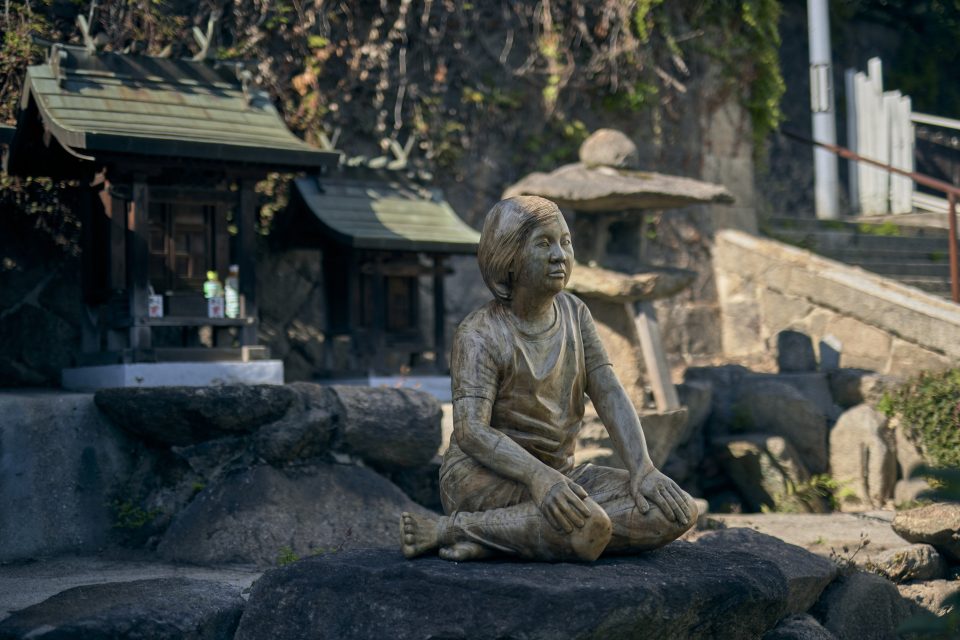
Installation view of work by Shooshie Sulaiman at her writing house in Onomichi, on view concurrently to “NEW LANDSKAP shooshie sulaiman” at the Onomichi City Museum of Art, 2023. All Images: Photo by Kenji Takahashi. ©︎ Shooshie Sulaiman, Courtesy of Tomio Koyama Gallery, Tokyo.
Malaysian artist Shooshie Sulaiman has a long-standing relationship with Japan, going back to her first extended stay in the country for an artist residency at Arcus Project in Moriya, Ibaraki Prefecture, in 1998. The artist, whose works range from drawings done in home-made, soil- and ash-based pigments to conceptual installations, has since developed a particularly deep connection to Onomichi, a small city in Hiroshima Prefecture overlooking the Seto Inland Sea. Since her first stay at AIR Onomichi in 2013, Sulaiman has returned to the city almost every year to continue developing projects there. Her long-term commitment culminated this year in a solo exhibition at Onomichi City Museum of Art, “NEW LANDSKAP shooshie sulaiman,” featuring site-specific installations that reflect the evolving landscape and history of the city.
ART iT began an email correspondence with Sulaiman on the occasion of her solo show “Lore of Equator,” held at Tomio Koyama Gallery, Tokyo, in 2021, during the Covid-19 pandemic. The following interview is a condensed and edited version of that exchange. An unedited version of this interview appears in the catalogue for “NEW LANDSKAP shooshie sulaiman.”
“NEW LANDSKAP shooshie sulaiman” opened at Onomichi City Museum of Art on September 16, 2023, and continues through November 12. A concurrent solo show of works related to Onomichi, “fake M.,” was on view at Tomio Koyama Gallery, Tokyo, September 1–22.
Interview
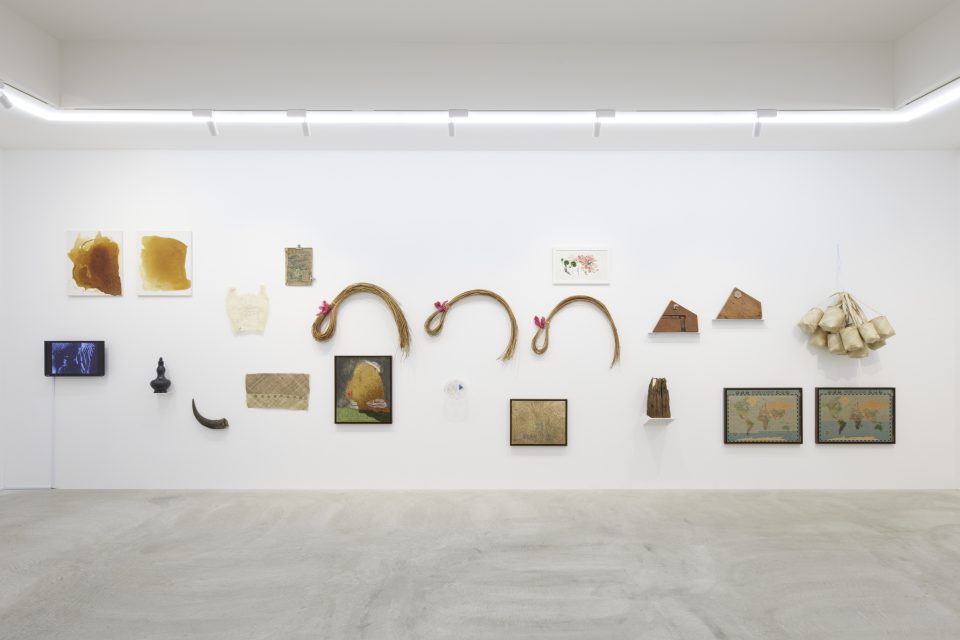
Installation view of “Lore of Equator,” Tomio Koyama Gallery, Tokyo, 2021.
ART iT: In “Lore of Equator” you create a multifaceted portrait of a particular region of the world out of everything from video and drawings to altered maps and assemblages of found objects as well as earthenware pitchers and woven baskets. At first, the diversity of the materials and techniques you employ seems to reflect a quintessentially “contemporary art” practice, but on second glance it also resembles the display strategies of ethnographic collections. Was that the intended effect? To what extent do you conceive of the display as a tool for storytelling or narrative?
Shooshie Sulaiman: When I use my external identity as a visual artist, I am aware that our brains allow us to communicate via visuals or symbolic texts, to externalize concepts, and to share complex ideas across generations. How people see an object is informed by their own social group’s intelligence, cultural traditions, and political values. In order to get my message/agenda/information across, or to legitimize communication/engagement with the audience, I employ a diversity of presentation and narrative approaches with an awareness of the parameters of their social value—and I think most artists are aware of their position in relation to the audience.
The “Lore of Equator” had to go through some typical narrative positioning, like installation art, video art, paintings, etc., and then the repositioning of found objects, crafts, and maps is like flipping your pancake so it cooks through. If one wants to address Tenggara in a white cube, that means representing diverse indigenous narratives. The Malays, Java, Khmer, Naga, Papuans, Torres Strait Islanders, Maori, Hawaiians, and Ainu are all “same-same but different.” To me, Malays can be found all over the world as indigenous or original peoples. They dispersed organically during the ancient floods—Nusantara origins. They were all great seafarers, great forest people, and amazing islanders.
In the first place, Tenggara was made from stories, not academic studies. Mysticism and myths were once the essence of Tenggara. All the elders played a role as storytellers to help us embrace our existence. I grew up with stories—not from a book, but from a storyteller, my late father. I remember vividly how Dad used to tell stories to all my friends in front of our house. My favorite was the legend about the dowry of the princess of the mountain Gunung Ledang. As a kid, my imagination went completely wild when I heard about the list of impossible conditions that the princess requested as her dowry to the Sultan of Malacca. Can you even imagine?
– Seven barrels of tears
– Seven trays filled with the hearts of mosquitoes
– Seven trays filled with the hearts of germs
– A golden bridge from Malacca to the mountain
– A silver bridge from the mountain to Malacca
– Seven barrels of young betel nut juice
– A bowl of the blood of the Sultan’s newborn son
Dad used to tell me to look at the mountain carefully on certain days—to look out for the golden bridge! He said some people are lucky to see it. And sometimes at night you can see many white ducks glowing by the roadside—with the condition that if you do see them, you must not say anything, and you must not stop your car. Magical things have very specific conditions. Your role is only to be a witness to the universe’s greatness. You must earn the trust of Mother Nature in order to learn her secrets. If you are lucky enough and the trust is there, you will be able to explore and tap into the energy of the universe. The knowledge will be delivered to you through the winds or your dreams. You can even request a bird to sing to you every morning at a requested place! (My father possessed this skill.)
Gunung Ledang is situated between the district of Muar, where I was born, and Segamat, where I attended primary and secondary school. My father served in the Forestry Department at Segamat for many years. He used to climb up Gunung Ledang to inspect and name the trees there. Whenever he came home I would be the first person to greet him and ask if he had any unusual encounters at the mountain. He never failed to tell me great stories! Sometimes he would take us there to camp and swim at the waterfalls.
Today, we retrieve facts from Google. It’s all dry information. Anyone can Google about Gunung Ledang, about the gold, or the princess’s dowry. But it is not the same as listening to storytellers. Their voices and facial expressions were the best “intellectual property” of our Nusantara origins. And mountains are where the stories come from. A mountain is like God—so important to indigenous tradition.
The ancient Malays had a profound relationship with their origins. The strong ties to the land they inhabited have been passed down to their descendants through stories. The flora and fauna showed them how to think of their identities and create ideas through culture and tradition. The sea was a curiosity and a need. It pushed them across the globe. The sky was a grand design. It mapped out all the secret vortex energy that they could tap to enhance their well-being and learn the power of the cosmos. We inherited these unique indigenous social and cultural traditions.
As I pursue the “Lore of Equator,” I realize some people may think I’m moving backward, straight into the past. If I take Tenggara as a typical narrative then, yes, I’m going back to ancient history. Yet my quest is the present and the reality of living. We forget we exist together with Mother Nature. The original Tenggara tradition and culture are about bonding and trust with our universe. We were once skilful enough to tap into peace and cure ourselves just by being part of nature.
Nowadays the Malays themselves think this narrative is quite lame and old fashioned. Sadly, everything clashes with economic imperatives. Capitalism creates greed, the drive to accumulate wealth. That’s why I believe the Sekolah Adat/Forest School is so important for retraining us in “Indigenous Attitude” and unpacking our capitalist mind patterns.
“Life” is completely digital on social media and circumscribed in our mental parameters. Body and mind have become separated. The strange and funny thing during the Covid-19 pandemic has been that humans were willing to imprison their themselves out of fear of death, yet our minds could still travel, go to work, and communicate even as our bodies have deteriorated.
The pandemic is an excellent example of how humans lose their existence on earth. Human intelligence has been corrupted by the evidence-based values they themselves created. The more we involve ourselves in human systems/laws, the more we lose interest in the mystical reality of ourselves in the universe, and instead create mechanisms for controlling human existence at large, such as machines and computer networks with standardized communication protocols. Since it was made solely for humans, not animals or trees or stars or rain, the system gets corrupted by humans all over again! Humans have lost their food for the soul. The soul is mystical—the soul sleeps with our universe. This persistent disconnection of body, mind, and soul unconsciously makes humans depressed and ill, and that anxiety immediately feeds greed and anger.
Nowadays anxiety replaces the soul. Economic default and social chaos. The climax of the human brain: burnout! Mental illness prevails. You are not living—you are imagining “living.” The human race got conned by their own minds. Bodies deteriorating. Senses numb. Soul extinct.
Covid-19 is just a scientific name that humans came up with. It is an animal–human chimera. But Covid-19 is real. Why? It causes death. The process of dying probably scares us more than anything else in life, because it leads to the great unknown event.
According to ancient lore, the equator has the most important points of free energy in the cosmos. Living with the equator is simple. Try to understand how to balance our body and soul with the cosmos, and how to tap that energy for our natural well-being. Build trust again with Mother Nature. Study with the forest people, who still preserve our ancient indigenous knowledge. All of us were indigenous in ancient times. We come from the same root. Why is it so difficult to stop our brains from manipulating us and taking control of our body and soul? We keep saying we seek a peaceful life, but we have forgotten our partners—our real universe, not our mental one. I learn from existing with the equator. My Nusantara world or Sundaland once was the center of an abundant wealth of cosmic energy, and I believe it still is. We need to relearn how to tap into it.
Making decisions for an exhibition is not easy for an artist. We are notorious for exaggerating the contexts of life. But somehow I tried to weave back our little flowers and start existing once again. I’m just a kindergarten student of the universe and I wish to be at this level for the rest of my life.
Some people may find it be a cliché, but I don’t mind showcasing something that is meaningful and real to my life. I’ve found my method, so why not share it with people who might be able to use it? If I can receive a miracle, why not other people? If art is such a useful tool, let’s spread the word about it.
Science makes you feel superior, stories make you feel that you exist. Let’s balance the two.
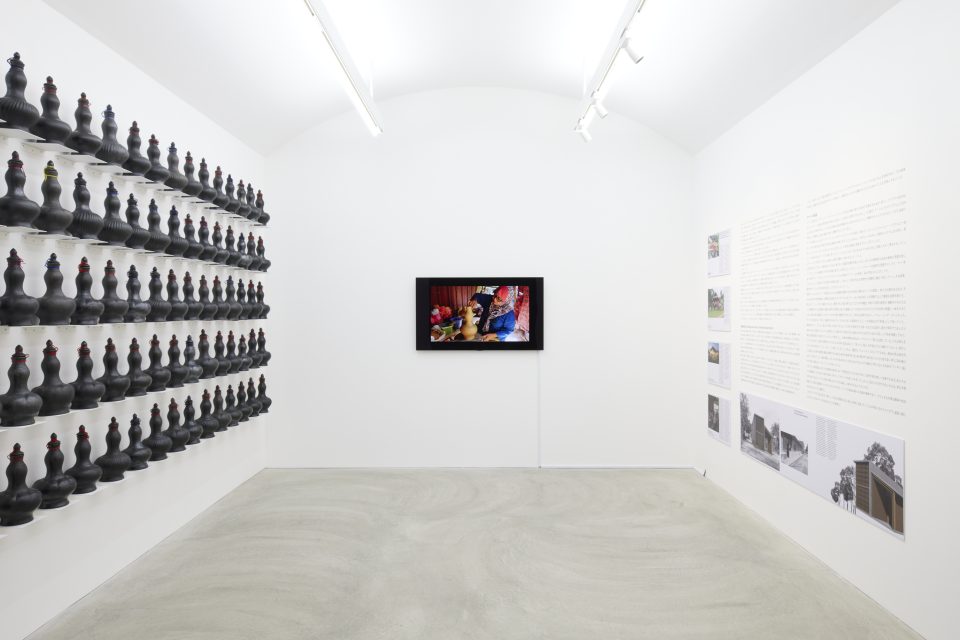
Installation view of “Lore of Equator,” Tomio Koyama Gallery, Tokyo, 2021.
ART iT: One of the main themes of the exhibition is conservation or preservation, as suggested by the installation of Mak Nah’s handmade Labu Sayong water pitchers in the first room of the gallery. But rather than treating the pitchers as museum pieces, you actively disperse them by selling them to visitors and then make that dispersal visible by leaving the spaces the pitchers occupied empty. Along with your use of materials ranging from plastic buckets to a water buffalo horn and a biodegradable plastic bag, this counterintuitively suggests to me an approach to preservation that accepts processes of obsolescence and deterioration, as well as hybridization and alteration, as part of a planetary life cycle. What possibilities do you see for further rethinking approaches to conservation through contemporary art?
SS: Contemporary art is an expression of our mistakes in life. It helps us to repair, restore, conserve, or reposition the mistakes. A mistake cannot be repeated, or it will remain a mistake forever. Creativity creates hope at a certain point. Hope is the reason for living.
Living with a corrupt government, I see how mistakes get normalized. It’s confusing and it eventually leads us to abandon our humanity as a substance in life. I’m not trying to be a hero, but as a creative person, I believe our brain is a gift. We are able to rethink our options. Why don’t we do something instead of complaining? After all, the creative process is very healthy and can help to improve life conditions for ourselves and others. It is so natural for us to revoke our survival skills when we are repressed—and for creative people that means revoking their creativity. The information era will soon die off without creative repositioning.
Before, I used art merely as expression. What if I used art to better the conditions that I find right in front of me? I have experienced many beautiful situations as a contemporary artist and I make use of my creative brain so that others can experience the beauty of life. One thing I learned from being a “normal” person is that survival is about repositioning. Everyone wants to escape from being bitter or being tested. It’s a life component; you can’t escape it. In order to embrace the opposite, we must experience it. When smartphones began to give fake entertainment to humans, I realized that artists can create better emotional options for everyone. The contemporary art that is categorized as high art today performs an aesthetic of risk, which is all about discovering new modes of value. It is capitalist cultural propaganda. As long as this is the case, art will remain an exclusive object without soul. Whereas for me, in my early years, art saved me as a healing mechanism. I found my medicine.
One part of my external identity is being a visual artist, but I have several others as a normal person in relation to my real environment. This environment is a source of tremendous inspiration, and I am indebted to it. Art can bridge an aesthetics of kindness between humans and their environments. Contemporary art is supposedly the finest application of the human brain, but can it do anything to reform the bitter human conditions manipulated by our social systems?
Everywhere today, politicians are out of control, abusing their power to promote business interests. We artists were once trapped in their agenda too. We used to think that our art gave us license to voice our critical views about politics. Yes, in some manner it does, but look at the world now. The system told us that we could shout and be critical, and then we would be important, famous, and remembered. Suddenly we found ourselves in the same boat as those selfish exclusive assholes who make a lot of money, travel everywhere across the world, and live a lavish life with the corrupt rich and famous people. Yet the issues or problems don’t go away, and nothing changes for the communities on whose behalf we are shouting! It shows now that artists’ voices do not bring justice to the issues, because the greed of the politicians ends up prevailing. Dumb leaders are everywhere.
Let’s reposition our contemporary art more intelligently than just politics. Don’t get trapped again. It’s a horrible stupidity. Start using our platform for something more meaningful to the public. Create better public options and even solutions. Team up with culturalists, anthropologists, scientists, environmentalists, naturalists, geologists, architects, engineers, or any other profession that will help us to live in respect with Mother Nature. If our ancestors could honor Mother Nature, we should strive to do better than them—for the sake of future generations.
In my work as an artist I celebrate contradiction as a perfect equation. I need to abstract both sides to better understand some issues. Everything is about training our understanding of knowledge. The best part in art is the beauty of abstraction. To be able to create myths, mystical entities, and rituals around objects. The unknown is so enchanting and feeds the human soul. Objects come to life with human touch. They live within us; our hands are the energy transmitter. Let’s transmit good energy. Let’s restore perception. If we use one of Mak Nah’s Labu pitchers to make good water for our body, then we can feel the good unknown inside us first and our vision of objects and living things will be peaceful. Your brain won’t manipulate you so much, because the water in your body reactivates all your senses. Let’s be respectful humans. Human conservation can be our first step.
My relationship with Mak Nah is about building a trust. That means transmitting and receiving feelings and enjoying each other’s company. Helping a loved one frees us from concerns of money or tangible returns. It sounds cliché, but that’s the key. The joy of making and doing things. This was my training for art and it is always an important motivation before I start anything. To allow someone to hold the Labu and bring it home to make good water for their body is also an act of contributing to a dying tradition. I believe the dispersal can foster emotional peace for the person. I have benefited from beautiful coincidences and paths through this training. My bad anxiety fades, and I receive peace. Peace is real. Humans corrupt it with greed, but peace is human intelligence.
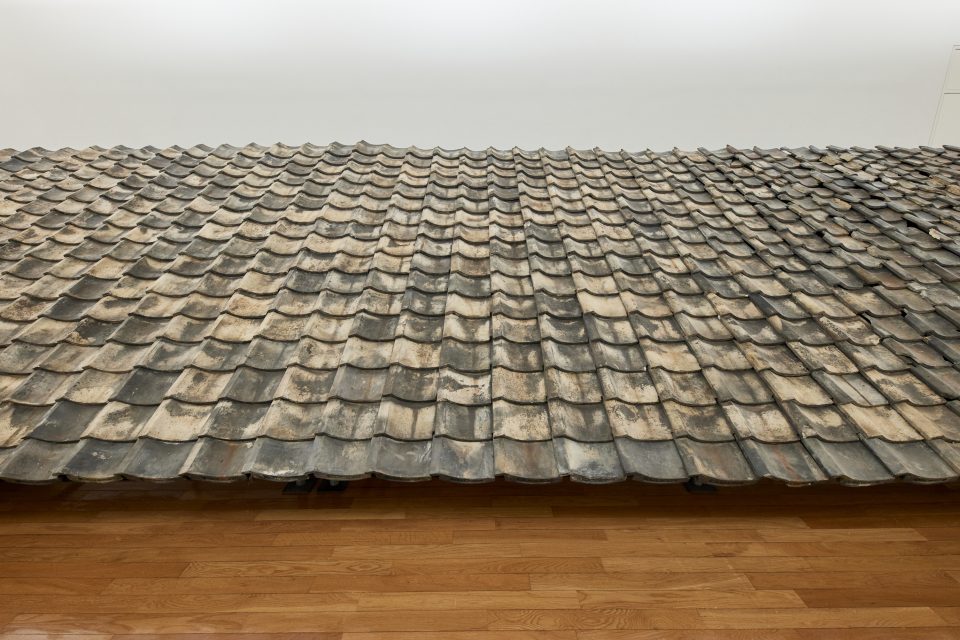
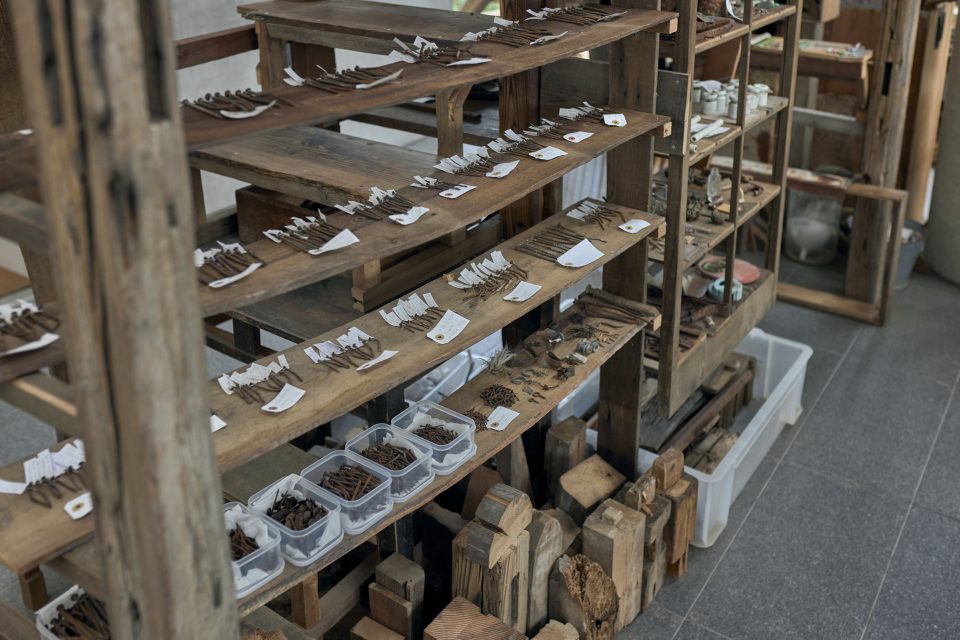
Both: Installation view of “NEW LANDSKAP shooshie sulaiman,” Onomichi City Museum of Art, 2023.
ART iT Until I saw your eponymous monograph published by Kerber Verlag in 2014, I hadn’t been fully aware of the depth of your engagement with Japan and Japanese culture. How do your experiences at residencies such as Arcus Project in Moriya and AIR Onomochi continue to shape your ideas about art?
SS: Residency programs are a kind of preprogramed migration, so sometimes they can be fake too. But it’s actually good to encounter a fake, because it allows us to see the real thing more clearly.
I went to Arcus at the very start of my artistic practice, in 1998. Everything seemed surreal and it left a deep impression on me. My experience of Japan was genuine then, as I had no expectations. I liked it so much. I still remember that naïve feeling. It was very fragile with regard to art, but strongly resonant with the landscape, spirituality, people, culture and life there. I was filled with admiration and wonder most of the time.
Toward the end of my stay my art charted an interesting path toward the ephemeral that still informs my work today. Every day was a dialogue between spirituality and science. (I even produced a dialogue with the autumn leaves outside my studio.) Just before coming to Japan I had attended the ASEAN COCI Youth Art Camp in Manila. My youthful emotions absorbed the SEA energy there and I took it with me to Moriya. There was no contradiction in that for me. At the time Tokyo (our nearest major art scene) was the hype of world contemporary art. (I saw Tatsuo Miyajima walking in his neon number suit.) Lee Wen was the only SEA artist I knew then, and he advised me to move to Japan because there was nothing like it in our region. I asked Tadashi Kawamata whether I needed to pursue further studies in art, and he said, “No need, you’re in Arcus.” Fumio Nanjo totally ignored my work. He said it was too SEA. Toshio Shimizu came and talked to me about Art Tower Mito and Fukuoka.
I can say that I was half–SEA (ephemeral) and half–Japan/Tokyo (aesthetic of risks) at the time. I went back to Malaysia and started incorporating ephemeral elements into my emotional quest in art. I was bashed left and right by my local scene. Some of my older peers even said it was a criminal idea and called me a “failure.” This was because I had abandoned the concept of the tangible object, without even having a Master’s degree or PhD to back it up! The scene was so small, and it scarred me. I decided to abandon the path of academia. I really felt academic artists belonged to an exclusive system for creating so-called knowledge in order to form another power system to control humans. I didn’t want to be trapped by this exclusive knowledge/power. I felt society should put knowledge to use to generate better options for living.
After I was chosen to participate in documenta 12, those artists stopped denouncing me, but they still gave me the silent treatment. Since my student years, I have used art to as a means to heal myself, and then it’s a bonus if anyone else appreciates it. What matters most to me is my quest in life, for which art is a great tool or method.
So silence me or not, it doesn’t matter. I choose people who are interested in learning what life has to offer together. Art is mostly a methodology for creating options. So the core for my production is always the process, not the final presentation. Process is the attitude. The final work is only the vessel/body.
The ancient cultures of Japan and Southeast Asia are very similar. I really believe that they share the same ancestry. The Southeast Asian people all have indigenous origins, and we have the potential to reactivate Indigenous Attitude in our contemporary life. It is our inheritance, and it has always been deeply rooted inside us. It was our original attitude. But most of the time it lies dormant, and we need to tap the cosmic energy to reactivate it, using symbols or objects or rituals as the transmitter. The animism of our ancestors proved that human and cosmos are one. We can tap the energy via our senses in certain landscapes/geographies.
Vessels like the landscape and the body are connected through a certain behavior/attitude in order to exist in the now. Spiritually guided by our past, our brain manipulatively imagines the future. Residency programs can be a good contradiction of temporary vessels (landscape and body). Usually, a short-term residency puts together a fake, preplanned stay or “touch-and-go” feeling. Artists are not able to position themselves as actors in the landscape. We reactivate our capacity for temporary observation via our senses. Our senses are quite receptive toward new environments, but in a residency we just stir the senses and leave. Contradictorily, we might stumble upon an overlapping “past” and “present” as a parallel inversion.
I was very young when I went to Arcus. Just as my temporary adjustment started to meld with the landscape, I had to say goodbye. It was good for making art, but not so much as for receiving cosmic energy. Japan has many pockets of energy that remain from its ancient animist cultures. That is why many foreigners have incredible experiences in Japan and with the Japanese people. The extreme life aesthetics of the Japanese derive from a continuous pattern of animist behavior and a great understanding of the relationship between humans and the cosmos. Contemporary Japanese people may not realize they are born with an indigenous mind pattern that is strongly connected to their culture. Amazingly, this comforting aesthetics has been unconsciously passed down through the generations as a great respect for Mother Nature. That’s why the Japanese relationship with nature and landscape or even the cosmos has a tremendous impact, one that is peaceful and beautiful.
AIR Onomichi is really vague and experimental. It’s beautiful. The director, Tamaki Ono, was my assistant at Arcus and we became friends during that time. He was a big believer in residency programs. After the first three months of his AIR Onomichi, I suggested to him the idea of a long-term residency as experimental vessel (landscape and body), which would give artists the chance to become attached to the environment as part of a temporary migration, like birds or butterflies.
He thought the idea was worth trying. He is also an artist and researcher, and he has a good understanding of animism. I hope his residency program can be a pioneer in helping to support artists in their knowledge production as a methodological component that leads to public intellectual positioning. It would be a very meaningful journey for a resident artist to become a contributor to temporary migration as a public creator in the landscape. The slow existence of the artist in the landscape is a process of approaching a practice of “sustainable aesthetics” that also has metaphysical dimensions.
Japanese culture and tradition are steeped in strong Eastern mysticism—cosmological readings that bridge the spiritual and physical, internal and external, micro and macro. The essence of sustainable living. Ancient Southeast Asia was the same. It had the kind of sustainable cultural ecosystem that is typical of Eastern cultures. But we lost that culture due to the colonizers. Japan is lucky it was able to avoid colonization.
So for me a residency in Japan is like revisiting a domain of Eastern mysticism that is still being practiced unconsciously. It’s as if every Japanese person has a quantum map imprinted in their brain and can unconsciously create various configurations of mystical states in the reading of life. That unconscious position engenders a self within societal patterns of interconnectedness. Surreally, we call those patterns “typically Japanese.”
I observed this when I tried to contextualize my “Otak Jepun” exchange program bringing Japanese people to the Malaysian rainforest. I saw a complimentary convergence between Indigenous Attitude and Otak Jepun (Japanese thinking). A balanced symbiosis.
Humans are deteriorating in today’s digital world. Our detachment from Indigenous Attitude makes us suffer from “soul disease.” We are all dying in our state of lower consciousness. The situation is worse for those us in the Eastern or equatorial regions, because we actually have better options, but we dismiss them as being outdated. The rampant celebration of digital power will bring an end to human spirituality, an end to enlightenment/awakening.
Art is our finest medium for thinking. Don’t turn it into entertainment.
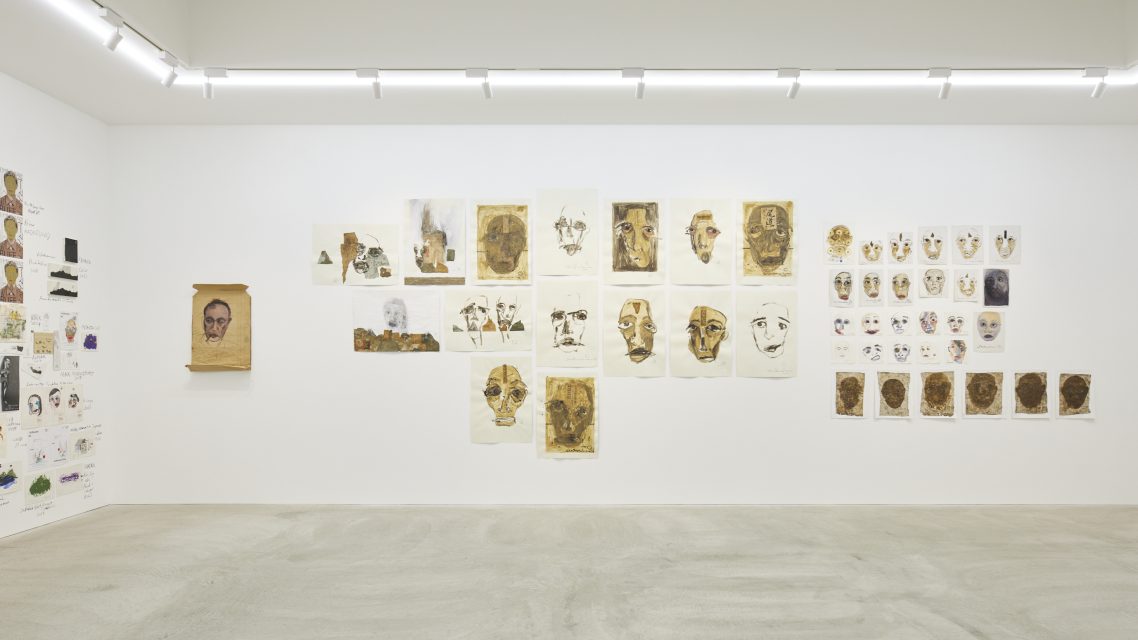
Installation view of “fake M.” Tomio Koyama Gallery, Tokyo, 2023.
TINGKAH LAKU ASAL / INDIGENOUS ATTITUDE MOVEMENT
Indigenous Attitude is something that we naturally have within us.
Our drive to survival. Our original skill.
Our way of finding peace with the Creator/Mother Nature.
This idea is an option for individuals from any type of landscape. It is a method for curing the human senses and reconnecting them with cosmic energy. It is a basic practice that is being replaced by digital technology. We need to reduce our reliance on digital technology to avoid mental and bodily illness.
1) Practice a manual lifestyle (basis of living)
– Manually cook your food. (Cooking skills, traditional/basic recipes, healthy ingredients). If you have a garden or plot in Southeast Asia, these plants are the basics: tapioca/cassava, banana, sugar palm, and coconut.
For a kitchen herb garden in an urban apartment: pandanus, lemon grass, turmeric, kaffir lime, etc.
– Make good water. Find a suitable clay vessel to keep or store drinking water. Water and clay/soil knowledge are essential for humans. Study how to cure water stress or learn about water memory. Clean and purify your body with good water.
– Planting and gardening. This practice is fundamental to understanding life and death. Experience growing something with your own hands. It is a miracle energy practice. The green is a source of detoxification. Flowers and green gardens are essential for reducing stress and blood pressure.
2) Purchase a forest and make it a private reserved forest
– The forest is the only solution for a perfect ecology.
– You can buy dry/sick land and turn in back into forest too.
– Watch Willie Smits of Samboja Lestari and Masarang Foundation. He cures rainforests and the equatorial green belt to help stop forest fires, floods, and soil erosion. At the same time, his work helps to economically sustain human lives, save wildlife, and protect Mother Earth.
– By purchasing your own forest, you will be more responsible toward the land and start educating yourself more about how to handle and understand forests. The important part is to become a good ecological actor for others.
– Name all your trees and plants with the forest people.
– Make your own botany books.
– Replant timber trees.
– Make the forest your university.
3) Sekolah Adat / Forest School
– Learn from the experts: the forest people / Orang Asli / indigenous tribes.
– Build a school together: go into the forest to find suitable trees, learn how to cut them down and carry them manually to the village. Map all the locations of the trees you cut down with GPS. Collect species samples (leaves, bark, flowers, and fruits) and make pressed plants. Study botanic architecture and replant the same species that the forest people use on your plot of land. You are planting your own university of nature.
– Learn the language and culture of the forest people.
– Be like a kindergarten student and make the native children your mentors for learning and play. The reverse psychology effects are very effective at restoring pride in their way of life.
– Document all the toys, games, recipes, musical instruments, weaving skills, and daily routines of forest culture.
4) Individual Urban Reforestation
– Study and plan your own urban landscape. Make your own nature trail and map.
– Throw earth balls/bombs everywhere (seedling clay balls—Masanobu Fukuoka) on abandoned lands. Be an Earth Soldier.
– Make an interior flower garden to purify your air (strong, resilient plants, like aloe vera, ficus, ivy, spider plants, snake plants, pence lily) and make a beautifully fragrant flower garden on any small, empty plot.
Southeast Asia is famous for its fragrant flowers. Make your air smell nice.
– Make a balcony forest/garden. (I once planted rice on my balcony, ha, ha, ha!) Your balcony needs to have visually beautiful flowering plants and smell good.
– Plant papaya trees on any available unused ground (e.g., by the roadside).
– Plant banana trees, tapioca, and moringa on any abandoned land.
– Plant baby raintrees by main thoroughfares.
Shooshie Sulaiman: Making History
